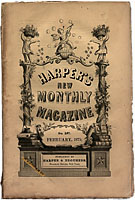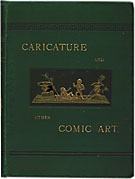|
Great Caricatures • Caricatures of the Ancients • |
 |
|
 |
|
© Great Caricatures
2005
![]() HISTORY
OF CARICATURE
HISTORY
OF CARICATURE ![]()
Caricatures of the Ancients

James Parton's article, Caricatures of the Ancients, was first published in Harper's Monthly Magazine, February 1875 as the first of a 12-part series. Two years later, the articles were collected and published as a book entitled Caricature and Other Comic Art published by Harper & Brothers.

Much as the ancients differed from ourselves in other particulars, they certainly laughed at one another just as we do, for precisely the same reasons, and employed every art, device, and implement of ridicule which is known to us.

Pigmy Pugilists -- from Pompeii

Chalk Caricature
on a Wall in Pompeii
Observe this rude and childish attempt at a drawing. Go into any boys' school today and turn over the slates and copy-books, or visit an inclosure where men are obliged to pass idle days, and you will be likely to find pictures conceived in this taste, and executed with this degree of artistic skill.
But the drawing dates back nearly eighteen centuries. It was done on one of the hot, languid days of August, A.D. 79, by a Roman soldier with a piece of red chalk on a wall of his barracks in the city of Pompeii.* On the 23d of August, in the year 79, occurred the eruption of Vesuvius which buried not Italian cities only, but Antiquity itself, and by burying preserved it for the instruction of after-times. In disinterred Pompeii the Past stands revealed to us, and we remark with a kind of infantile surprise the great number of particulars in which the people of that,day were even such as we are.
There was found the familiar apothecary's shop, with a box of pills on the counter, and a roll of material that was about to be made up when the apothecary heard the warning thunder and fled. The baker's shop remained, with a loaf of broad stamped with the maker's name. A sculptor's studio was strewn with blocks of marble, unfinished statues, mallets, compasses, chisels, and saws. A thousand objects attest that when the fatal eruption burst upon these cities life and its activities were going forward in all essential particulars as they are at this moment in any rich and luxurious city of Southern Europe.
In the building supposed to have been the quarters of the Roman garrison many of the walls were covered with such attempts at caricature as the specimen just given, to some of which were appended opprobrious epithets and phrases. The name of the personage above portrayed was Nonius Maximus, who was probably a martinet centurion, odious to his company, for the name was found in various parts of the inclosure, usually accompanied by highly disparaging words. Many of the soldiers had simply chalked their own names; others had added the number of their cohort or legion, precisely as in the late war soldiers left records of their stay on the walls of fort and hospital. A large number of these wall chalkings in red, white, and black (most of them in red) were clearly legible fifty years after exposure. Here is another specimen, a genuine political caricature, copied from an outside wall of a private house in Pompeii.
The allusion is to an occurrence in local history of the liveliest possible interest to the people. A few years before the fatal eruption there was a fierce town-and-country row in the amphi-theatre, in which, the Pompeians defeated and put to flight the provincial Nucerians. Nero condemned the pugnacious men of Pompeii to the terrible penalty of closing their amphi-theatre for ten years. In the picture an armed man descends into the arena bearing the palm of victory, while on the other side a prisoner is dragged away bound.

Chalk Caricature on a Wall in Pompeii
If the idlers of the streets chalked caricature on the walls we can not be surprised to discover that Pompeian artists delighted in the comic and burlesque. Comic scenes from the plays of Terence and Plautus, with the names of the characters written over them, have been found, as well as a large number of burlesque scenes, in which dwarfs, deformed people, Pigmies, beasts, and birds are engaged in the ordinary labors of men. The gay and luxurious people of the buried cities seem to have delighted in nothing so much as in representations of Pigmies, for there was scarcely a house in Pompeii yet uncovered which did not exhibit sonic trace of the ancient belief in the existence of these little people. Homer, Aristotle, and Pliny all discourse of the Pigmies as actually existing, and the artists availing themselves of this belief, which they shared, employed it in a hundred ways to caricature the doings of men of larger growth. Pliny describes them as inhabiting the salubrious mountainous regions of India, their stature about twenty-seven inches and engaged in eternal war with their enemies the geese. "They say," Pliny continues, "that, mounted upon rams and goats, and armed with bows and arrows, they descend in a body during spring-time to the edge of the waters, where they eat the eggs and the young of those birds, not returning to the mountains for three months. Otherwise they could not resist the ever-increasing multitude of the geese. The Pigmies live in cabins made of mud, the shells of goose eggs, and feathers of the same bird."

Battle Between Pigmies and Geese
To be continued ...